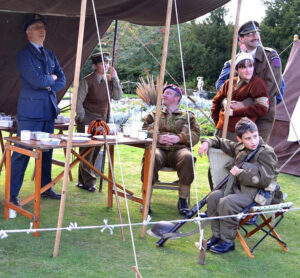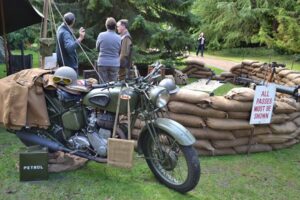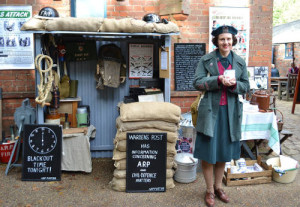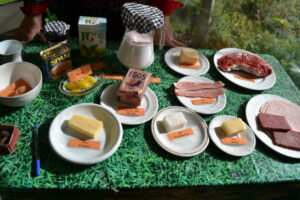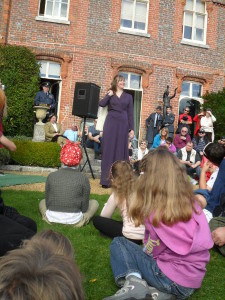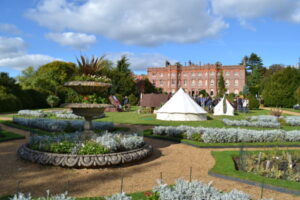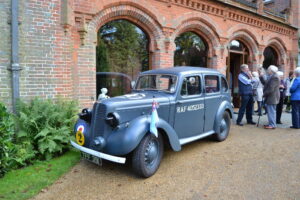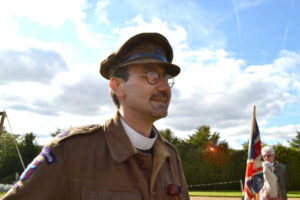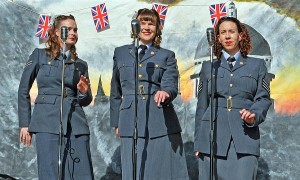
Every year in October, Hughenden Manor in Buckinghamshire has a 1940s weekend, bringing together war time reenactment groups, old vehicles, and those who like to dress up in a great display of 1940s exuberance.
My husband and I went along this year to enjoy the fun and soak up the atmosphere. As we walked up the path towards the manor house, we passed a display of 1940s artillery and a mock fortress showing how sandbags were used to protect soldiers in the trenches from enemy fire. The soldier in charge of the guns was showing off his ammunition and hand grenades.
A stuffed dog and a messenger pigeon caught our eye. The soldier explained that dogs were an integral part of the wartime rescue effort, helping to find people trapped in the rubble of bombed buildings. For those who were injured, there was a medical tent complete with supplies, put-you-up beds and an old fashioned commode.
A lady making brooches from painted nut shells had attracted a small crowd: “Here’s an original brooch from the 1940s,” she said as she showed us. “We make do and mend everything,” she added. “This is a bit of old army tunic, which I’m using as the background for my brooch.” Two people in 1940s dress cycled past. Then we walked around the back of the manor to see a fashion show which had begun on the patio. 1940s music filled the air as the fashion show gathered momentum. Two ladies took to the catwalk parading in daywear, evening wear, underwear, and even bridal wear.
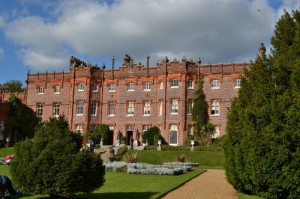 Among the most memorable outfits was a rabbit skin coat and a nylon dress. The ladies were excited about nylon because it was a new invention in the 1940s, named after the cities where it had been developed, New York and London. It was first used for parachutes. They wore red lipstick and said it was the women’s duty to make themselves beautiful and to keep everyone’s spirits up during the war. Apparently the ladies watching the fashion parade were letting the side down by not wearing red lipstick.
Among the most memorable outfits was a rabbit skin coat and a nylon dress. The ladies were excited about nylon because it was a new invention in the 1940s, named after the cities where it had been developed, New York and London. It was first used for parachutes. They wore red lipstick and said it was the women’s duty to make themselves beautiful and to keep everyone’s spirits up during the war. Apparently the ladies watching the fashion parade were letting the side down by not wearing red lipstick.
“I work in the munitions factory,” said one of the ladies. “You haven’t been there long then,” said another. The first lady looked at her. “No, just a week” she replied. “I can tell. The chemicals used in the factory will make your skin turn yellow in time,” said the first. The factory worker pulled a face. “Not a good look. It won’t go with the lip stick!”
During the war, cosmetics were hard to come by so the ladies used shoe polish and soot on their eyelashes and eyebrows instead of mascara. They explained how the absence of many commodities resulted in creativity and new uses for old things. They had made a lot of their own clothes – some
from surplus parachute fabric or old tablecloths.
As the fashion show came to an end,
I met a padre who told me that they went to war unarmed, to bring injured soldiers back on stretchers and help where they could. But the padre’s role was more than just a religious leader.
He was there to help with the welfare of the soldiers and airmen, and that meant everything from organising dances and other social events, to helping them with spiritual matters. “I can’t imagine myself going to war,” said Neil, the actor playing the role of the padre, “but because padres were unarmed, they usually had the respect of enemy soldiers and would be allowed to walk around freely.”
Finally, in the courtyard was a small tent full of information about the Women’s Voluntary Service. It was formed in
1938 in anticipation of war. 960,000 women engaged in tasks from billeting and welfare of evacuees, to running rest centres and incident enquiry points. They took on catering duties, knitted comforters for the troops, organised accommodation, food and mobile laundries for the homeless, gathered information on casualties; and assisted with the bereaved. It was a fascinating day of nostalgia, brought to life by a wonderful array of actors and enthusiasts.
Susie Kearley



